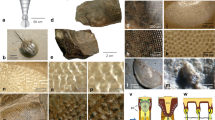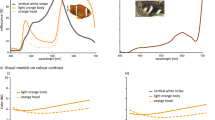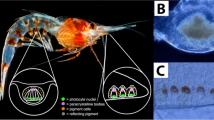Abstract
Hydrothermal vents along the mid-ocean ridges host ephemeral ecosystems of diverse endemic fauna including several crustacean species1,2,3,4, some of which undergo planktonic development as larvae up to 1,000 m above and 100 km away from the vents5,6. Little is known about the role of vision in the life history of vent fauna. Here we report that planktonic zoea larvae of the vent crab Bythograea thermydron possess image-forming compound eyes with a visual pigment sensitive to the blue light of mesopelagic waters. As they metamorphose and begin to descend to and settle at the vents, they lose their image-forming optics and develop high-sensitivity naked-retina eyes. The spectral absorbance of the visual pigment in these eyes shifts towards longer wavelengths from larva to postlarva to adult. This progressive visual metamorphosis trades imaging for increased sensitivity, and changes spectral sensitivity from the blue wavelengths of the larval environment towards the dim, longer wavelengths7 produced in the deeper bathypelagic vent environment of the adults. As hydrothermal vents produce light7, vision may supplement thermal and chemical senses to orient postlarval settlement at vent sites.
This is a preview of subscription content, access via your institution
Access options
Subscribe to this journal
Receive 51 print issues and online access
$199.00 per year
only $3.90 per issue
Buy this article
- Purchase on Springer Link
- Instant access to full article PDF
Prices may be subject to local taxes which are calculated during checkout


Similar content being viewed by others
References
Grassle, J. F. Hydrothermal vent animals: distribution and biology. Science 229, 713–717 (1985)
Rona, P. A., Klinkhammer, G., Nelsen, T. A., Trefry, J. H. & Elderfield, H. Black smokers, massive sulphides and vent biota at the Mid-Atlantic Ridge. Nature 321, 33–37 (1986)
Van Dover, C. L. Hydrothermal Vents and Processes (eds Parson, L. M., Walker, C. L. & Dixon, D. R.) Special Publication No. 87 257–294 (Geological Society, London, 1995)
Van Dover, C. L. et al. Biogeography and ecological setting of Indian Ocean hydrothermal vents. Science 294, 818–823 (2001)
Herring, P. J. & Dixon, D. R. Extensive deep-sea dispersal of postlarval shrimp from a hydrothermal vent. Deep-Sea Res. I 45, 2105–2118 (1998)
Pond, D., Dixon, D. & Sargent, J. Wax-ester reserves facilitate dispersal of hydrothermal vent shrimps. Mar. Ecol. Prog. Ser. 146, 289–290 (1997)
Van Dover, C. L., Reynolds, G. T., Chave, A. D. & Tyson, J. A. Light at deep-sea hydrothermal vents. Geophys. Res. Lett. 23, 2049–2052 (1996)
Renninger, G. H. et al. Sulfide as a chemical stimulus for deep-sea hydrothermal vent shrimp. Biol. Bull. 189, 69–76 (1995)
Van Dover, C. L., Szuts, E. Z., Chamberlain, S. C. & Cann, J. R. A novel eye in ‘eyeless’ shrimp from hydrothermal vents of the Mid-Atlantic Ridge. Nature 337, 458–460 (1989)
O'Neill, P. J. et al. The morphology of the dorsal eye of the hydrothermal vent shrimp, Rimicaris exoculata. Vis. Neurosci. 12, 861–875 (1995)
Jinks, R. N. et al. Sensory adaptations in hydrothermal vent shrimps from the Mid-Atlantic Ridge. Cah. Biol. Mar. 39, 309–312 (1998)
Cronin, T. W. & Jinks, R. N. Ontogeny of vision in marine crustaceans. Am. Zool. 41, 1098–1107 (2001)
Epifanio, C. E., Perovich, G., Dittel, A. I. & Cary, S. C. Development and behavior of megalopa larvae and juveniles of the hydrothermal vent crab Bythograea thermydron. Mar. Ecol. Prog. Ser. 185, 147–154 (1999)
Land, M. F. The sight of deep wet heat. Nature 337, 404 (1989)
Gaten, E., Herring, P. J., Shelton, P. M. J. & Johnson, M. L. Comparative morphology of the eyes of postlarval bresiliid shrimps from the region of hydrothermal vents. Biol. Bull. 194, 267–280 (1998)
Herring, P. J., Gaten, E. & Shelton, P. M. J. Are vent shrimps blinded by science? Nature 398, 116 (1999)
Frank, T. M. & Case, J. F. Visual spectral sensitivities of bioluminescent deep-sea crustaceans. Biol. Bull. 175, 261–273 (1988)
White, S. N., Chave, A. D. & Reynolds, G. T. Investigations of ambient light emission at deep-sea hydrothermal vents. J. Geophys. Res. 107, EPM 1–13 (2002)
Tapley, D. W., Buettner, G. R. & Shick, J. M. Free radicals and chemiluminescence as products of the spontaneous oxidation of sulfide in seawater, and their biological implications. Biol. Bull. 196, 52–56 (1999)
Bennett, J. T. & Turekian, K. K. Radiometric ages of brachyuran crabs from the Galapagos spreading-center hydrothermal ventfield. Limnol. Oceanogr. 29, 1088–1091 (1984)
Cronin, T. W., Marshall, N. J., Caldwell, R. L. & Pales, D. Compound eyes and ocular pigments of crustacean larvae (Stomatopoda and Decapoda, Brachyura). Mar. Freshwat. Behav. Physiol. 26, 219–231 (1995)
Stavenga, D. G., Smits, R. P. & Hoenders, B. J. Simple exponential functions describing the absorbance bands of visual pigment spectra. Vision Res. 33, 1011–1017 (1993)
Williams, A. B. A new crab family from the vicinity of submarine thermal vents on the Galapagos Rift (Crustacea: Decapoda: Brachyura). Proc. Biol. Soc. Wash. 93, 443–472 (1980)
Acknowledgements
We thank the captain and crew of the RV Atlantis, the DSV Alvin group, and members of the Epifanio laboratory for animal collection. We thank J. J. McDermott for comments on the manuscript. This work was supported by the National Science Foundation (A.I.D., C.E.E. and T.W.C.) and by Franklin and Marshall College.
Author information
Authors and Affiliations
Corresponding author
Ethics declarations
Competing interests
The authors declare that they have no competing financial interests.
Rights and permissions
About this article
Cite this article
Jinks, R., Markley, T., Taylor, E. et al. Adaptive visual metamorphosis in a deep-sea hydrothermal vent crab. Nature 420, 68–70 (2002). https://doi.org/10.1038/nature01144
Received:
Accepted:
Issue Date:
DOI: https://doi.org/10.1038/nature01144
This article is cited by
-
Pelagic organisms avoid white, blue, and red artificial light from scientific instruments
Scientific Reports (2021)
-
Seeing double: visual physiology of double-retina eye ontogeny in stomatopod crustaceans
Journal of Comparative Physiology A (2015)
-
Difference in light perception capability and spectral response between juveniles and sub-adults of the whiteleg shrimp Litopenaeus vannamei as determined by electroretinogram
Fisheries Science (2010)
-
Exceptional Variation on a Common Theme: The Evolution of Crustacean Compound Eyes
Evolution: Education and Outreach (2008)
-
Survival of Deep-Sea Shrimp (Alvinocaris sp.) During Decompression and Larval Hatching at Atmospheric Pressure
Marine Biotechnology (2005)
Comments
By submitting a comment you agree to abide by our Terms and Community Guidelines. If you find something abusive or that does not comply with our terms or guidelines please flag it as inappropriate.



